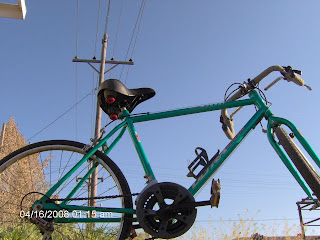I made a laptop. It won honorable mention in the Parallax 2008 Propeller Design Contest. The point of the contest was to do something that shows off the unique capabilities of the Propeller microcontroller. I made a 6502-based laptop that uses the Propeller as its "chipset". I started with a toy laptop, and replaced all of the electronics with my own design to make it into a real working computer.
The screen is a 5.5 inch LCD TV for the laptop screen. The video decoder board, which was piggybacked on the LCD, made too tall a stack to fit inside the screen. After watching this presentation about modding by Benjamin Heckendorn, I decided not to try to make the laptop thicker. He gives the advice that you have to pick a height constraint and stick to it or else your project will grow to be "the Marvel Mystery House." Instead I figured out a way to unfolded the TV circuit board flat and place it below (not behind) the screen. Unfortunately that makes the LCD sit very high up the lid, so I made a nice decorative faceplate to distract the eye from how high and small the screen is.
The battery holder is embedded face up in the bottom so I wouldn't have to fashion a battery cover; the lid keeps the batteries in place when the laptop is closed.
Inside the laptop: at the top of the picture you see the back of the keyboard. In the second row, components from left to right: the keyboard decoder, back of the battery holder, and the CPU board. (More on the CPU board in a minute.) This toy laptop had a QWERTY keyboard, but it was not PS/2. Decoding this key matrix with the Propeller would be a waste of I/O pins. I realized that all keyboards are key matrices, including standard computer keyboards. So I simply cut the circuit board out of a real PS/2 keyboard from a Dell PC, and soldered the toy keyboard to the PS/2 board! The fact that that actually works (it does work!) is hilarious. Of course the key codes generated will be different; for instance pressing "A" might make the PS/2 board think you are pressing "X", but I simply translate the keycodes in software.
The laptop is based on a 6502 processor. I used the Propeller microcontroller as the "chipset" for the computer. The Propeller provides video, I/O, and memory control. The 6502 addresses a 64K static RAM chip, and the Propeller manipulates the control signals in order to load the initial program and monitor the address and data buses. Reducing chip count was key to making this board fit inside the laptop shell.
The reason I was able to do it with so few chips is a combination of the Propeller microcontroller's versatility, and a neat timing trick that allowed me to multiplex the data bus. After reading how old 6502 computers interleaved video access with processor accesses on the same bus, I realized I could use the same technique to allow the Propeller to access the bus in the interim period between each 6502 bus cycle. Since the 6502 puts the address out before the data is read or written, the Propeller can quickly transfer the 16 bit address onto the 8 bit data bus in two transfers, and still finish in time to return the data bus to a "normal" state so that the 6502 never knows anything happened.
What I learned from this project is that pins and signals are ways of dividing up the physical dimensions, but you can also think of time as a dimension that can be sliced up and parceled out. Making use of this extra dimension in a design can allow you to fold a complex system into a smaller physical space than it would seem to fit.
Once you've pared down your design, you've still got to wire it, and even a simple computer involves a nightmare of wiring. This part is harder than choosing the right chips to wire in the first place!
In a closely packed board, you can have a problem wiring it just from the sheer mass of copper packed into each square inch. I used strips cut from 80 conductor IDE ribbon cables to wire up the board. (Credit to Benjamin Heckendorn for giving this advice as well, in the same presentation I mentioned above.) These extremely thin IDE cable wires allowed me to pack more wiring into a smaller space, and it makes the wiring neater when you can group 4 or 8 together into ribbon cables.
This project gave me an excuse to finally use my Fluke 9010A Microcomputer Troubleshooter (pictured, front and center). My friend and former teacher, Earl Martin, once told me there were only ever two pieces of electronics equipment he wanted his whole life. One is a multichannel logic analyzer; the other is this Fluke 9010A, which he gave to me.
What this unit allows you to do is plug in to the CPU socket of a computer and exercise control of any aspect of the computer. You can test bus signals, read/write memory, even run programs and break on conditions. Technically it's an in-circuit emulator, but that term doesn't begin to cover the depth of what this tool can do. I would not have even attempted this project without it.
I had hoped to get better than honorable mention, but at least I'm on the same web page with the other winners, and received a $100 prize. I took the prize payment in the form of $100 of Parallax electronics components. I used the prize from this contest to buy parts for my project for next year's Propeller design contest: Norbert 2.0, a Propeller-controlled mobile Lego robot with a 5-degree of freedom manipulator arm. See you next time!



















































